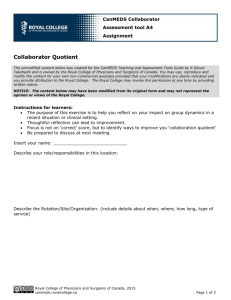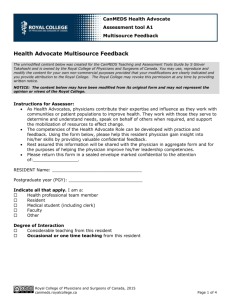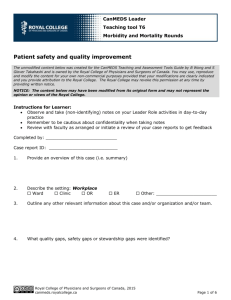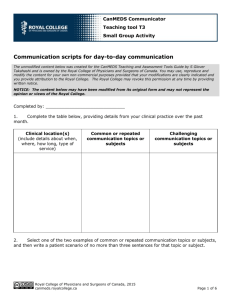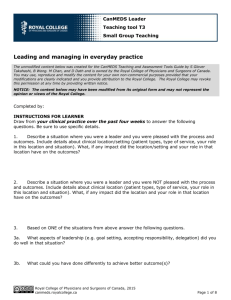MS Word
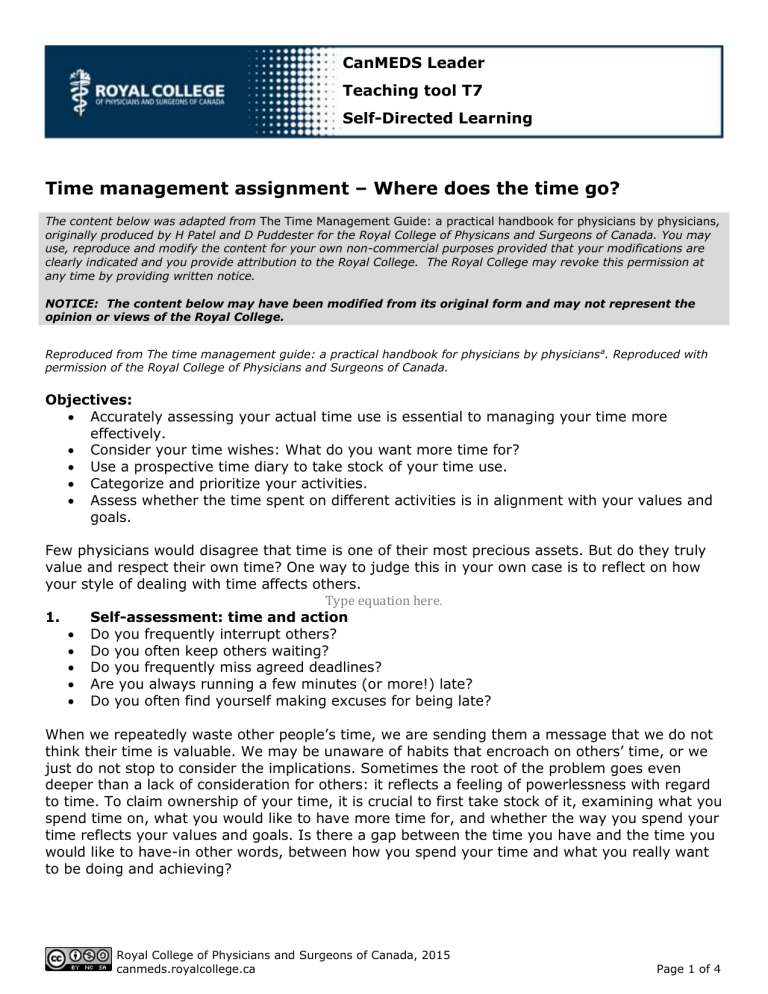
CanMEDS Leader
Teaching tool T7
Self-Directed Learning
Time management assignment – Where does the time go?
The content below was adapted from The Time Management Guide: a practical handbook for physicians by physicians, originally produced by H Patel and D Puddester for the Royal College of Physicans and Surgeons of Canada. You may use, reproduce and modify the content for your own non-commercial purposes provided that your modifications are clearly indicated and you provide attribution to the Royal College. The Royal College may revoke this permission at any time by providing written notice.
NOTICE: The content below may have been modified from its original form and may not represent the
opinion or views of the Royal College.
Reproduced from The time management guide: a practical handbook for physicians by physicians a . Reproduced with permission of the Royal College of Physicians and Surgeons of Canada.
Objectives:
Accurately assessing your actual time use is essential to managing your time more effectively.
Consider your time wishes: What do you want more time for?
Use a prospective time diary to take stock of your time use.
Categorize and prioritize your activities.
Assess whether the time spent on different activities is in alignment with your values and goals.
Few physicians would disagree that time is one of their most precious assets. But do they truly value and respect their own time? One way to judge this in your own case is to reflect on how your style of dealing with time affects others.
Type equation here.
1. Self-assessment: time and action
Do you frequently interrupt others?
Do you often keep others waiting?
Do you frequently miss agreed deadlines?
Are you always running a few minutes (or more!) late?
Do you often find yourself making excuses for being late?
When we repeatedly waste other people’s time, we are sending them a message that we do not think their time is valuable. We may be unaware of habits that encroach on others’ time, or we just do not stop to consider the implications. Sometimes the root of the problem goes even deeper than a lack of consideration for others: it reflects a feeling of powerlessness with regard to time. To claim ownership of your time, it is crucial to first take stock of it, examining what you spend time on, what you would like to have more time for, and whether the way you spend your time reflects your values and goals. Is there a gap between the time you have and the time you would like to have-in other words, between how you spend your time and what you really want to be doing and achieving?
Royal College of Physicians and Surgeons of Canada, 2015
canmeds.royalcollege.ca Page 1 of 4
CanMEDS Teaching and Assessment Tools Guide Leader teaching tool T7
2.
3.
Time wishes
Spend a few minutes to consider this question: What do you want more time for? What are the first things that jump to mind? Take a few moments to consider your time wishes, both personal and professional. They are both important.
Self-assessment: time wishes
Three things I would do if I had more personal time, or that I wish I had more time for, are:
1.
2.
Three things I would do if I had more professional time, or that I wish I had more time for, are:
1.
3.
The activities that are most important to you are likely those that came to mind first. There are no right or wrong answers. The fact that the number of minutes in the day is finite means that, to attain any of these wishes, you will need to eliminate another current activity—hopefully, a time-waster.
Time-wasters
Now try to identify habits, actions, and responsibilities that waste your time. What we are really talking about are undesired, possibly unproductive, activities. Take a few moments to jot down the top five things that you would rather do less often or not at all.
Self-assessment: time-wasters
Three things that waste my time or that I’d rather stop doing are:
1.
3.
2.
Time-wasters come in two forms: the obvious and the not-so-obvious that are contextual and highly personal. Physicians often say that their time is wasted by email, paperwork, administrative tasks, and unimportant interruptions. On the home front, housework, the
Internet, and television are frequently cited.
Royal College of Physicians and Surgeons of Canada, 2015
canmeds.royalcollege.ca Page 2 of 4
CanMEDS Teaching and Assessment Tools Guide Leader teaching tool T7
The not-so-obvious time-wasters are the dangerous ones, for they can siphon away our time without us even noticing. Procrastination is a good example of an occult time-waster. Chit-chat, the social glue that helps hold teams together, can insidiously move from team builder to timewaster. But the most dangerous time-waster is a lack of personal direction. See Chapter three of
Patel H, Puddester D. The time management guide: A practical handbook for physicians by
physicians. Ottawa: Royal College of Physicians and Surgeons; 2012 for tips to develop personal direction.
2. Keeping a time diary
Much like a budget helps us with financial planning we need to draw up a “budget” for allocating our time. First, consider how your time is being spent currently. There are retrospective and prospective approaches to this task.
A retrospective accounting
A retrospective review of recent activities using your agenda, calendar, or planner can help you assess how you are spending your time. If you don’t have a paper or electronic agenda, this approach won’t work. If you do use an agenda, can you see how your time was spent in blocks of 30 minutes or less? Is it clear what you intended to accomplish on any given day? Did you succeed? Do you know where last week went? Are you able to identify any specific time-wasting activities? On the positive side, what desired tasks were you able to complete?
A prospective diary
Keeping a prospective time log or diary is the single best way to determine your actual time use.
The quickest and easiest way to do this is with pen and paper.
1. Method one: Create a grid (with 15- or 30-minute time slots on a sheet of paper. Fold the paper up and carry it in your pocket with a pen. Write down your main activity in every block of time.
2. Method two: Record your time use with dictation or by using a mobile device. You will need to transcribe the results, as opposed to doing a quick overview on paper.
3. Method three: Keep a small pad of Post-it notes in your pocket and write the time and activity down every 30 minutes.
You will learn a lot from recording a day’s worth of activities, and even more by looking at a series of days, especially if your daily tasks vary significantly through the week. It is crucial to record activities as they truly happen, even when they are unexpected.
When you try the time diary, you may find that the process of keeping a record is itself therapeutic. Just by being aware of your time, you will start to see your management of it in a different light. You may even find yourself making modifications through the course of the day in response to what you are noticing. It is similar to when we ask patients with chronic conditions such as headaches to keep diaries to help identify patterns and triggers. Diaries work well when self-reflection and behaviour modification are a key part of the intervention.
3. Analyzing your time use
Once you have collected some real data from your time diary, you will be ready to do some analysis. To borrow some advice from the business literature on time management, it’s time to see whether your “commitments match your convictions.” b
Royal College of Physicians and Surgeons of Canada, 2015
canmeds.royalcollege.ca Page 3 of 4
CanMEDS Teaching and Assessment Tools Guide Leader teaching tool T7
Consider how you are spending your time now. What proportion of your day is spent doing the things that you want to do? Are you comfortable with this balance? Look through the activities recorded in your time diary and jot down whether this matches your goals.
You are most likely to be effective in reaching your goals when you invest time in planning and preparation. Spend as little as possible on unimportant tasks and as much as possible on nonurgent but important tasks.
Other resources for time management:
One of the best-known ways to start working on this is to apply Stephen R. Covey’s Time
Management Matrix.
c Developed decades ago, this model is still useful. Steven Covey suggests that we organize our activities and align our time so that we don’t confuse urgency with importance, and short term with longer term outcomes.
There are, of course, other models for categorizing time use. All are based on the prioritization of tasks. For example, Brian Tracy, in his highly readable book Eat That Frog!, d describes a system in which, on a given day, “A” tasks must be done, “B” tasks should be done, “C” tasks could be done, “D” tasks could be delegated to someone else, and “E” tasks could be eliminated.
In a similar vein, David Sackett, in a series of articles on time management for clinical scientists, e suggests that all tasks be divided into: (a) items that the individual is doing and wants to keep doing; (b) items that the individual is doing and wants to stop; (c) items that the individual is not doing and wants to start; and (d) strategies that can be used to improve the balance between these categories. No matter which system you use, the key elements in analyzing your time are the same: taking stock of your actual time use, categorizing your activities with respect to priorities, and considering to what extent the proportion of time you spend on different types of activities matches your real values, objectives, and aspirations. a Patel H, Puddester D. The time management guide: a practical handbook for physician by physicians. Ottawa: Royal
College of Physicians and Surgeons of Canada; 2012. Reproduced with permission. b Sull DN, Houlder D. Do your commitments match your convictions? Boston: Harvard Business Press; 2005. c Covey SR. The 7 habits of highly effective people. New York: Free Press; 1989. d Tracy B. Eat that frog! 2nd ed. San Francisco: Berrett-Koehler Publishers; 2006. p 37–40. www.briantracy.com e Sackett DL. Clinician-trialist rounds: 3. Priority setting for academic success. Clin Trials. 2011;8(2):235–7.
Permission to use provided by Sage Publications Ltd. www.sage.pub.co.uk
Royal College of Physicians and Surgeons of Canada, 2015
canmeds.royalcollege.ca Page 4 of 4
